Get the latest updates about solar activity!
Solar Activity
The Sun is not just a big bright ball. It has a complicated and changing magnetic field, which forms things like sunspots and active regions.
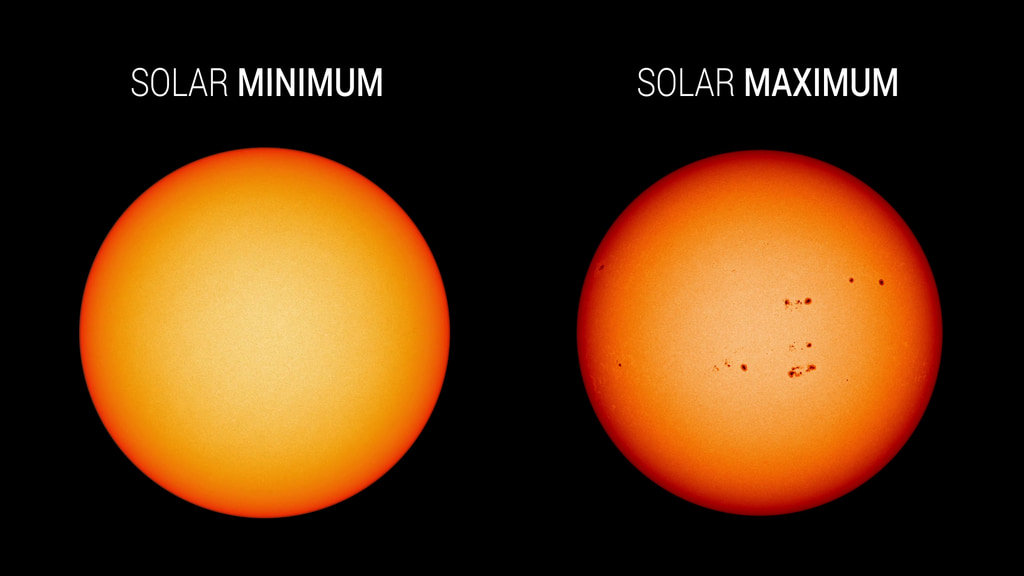
The Sun is in Solar Cycle 25
Solar minimum occurred in December 2019, marking the transition into a new solar cycle. We are currently in solar maximum. Scientists think the peak may be August 2024.
A new solar cycle comes roughly every 11 years.
Over the course of each cycle, the Sun transitions from relatively calm to active and stormy, and then quiet again. Near the peak, the Sun’s magnetic poles flip.
The Sun’s Magnetic Field
The solar magnetic field changes on an 11-year and 22-year cycle.
Every solar cycle, the number of sunspots, flares, and solar storms increases to a peak, known as the solar maximum.
Then, after a few years of high activity, the Sun will ramp down to a few years of low activity, known as the solar minimum. This pattern is called the “sunspot cycle”, the “solar cycle”, or the “activity cycle”.
The regions overlying sunspots are called active regions. Here the sun’s magnetic field becomes concentrated and twisted because of the motions of the solar atmosphere at and below the solar surface. As these regions become more complex they can eventually become unstable causing the release of the magnetic energy. This is analogous to twisting a rubber band tighter and tighter until it snaps releasing energy in the form of heat and motion. The same thing happens in the solar atmosphere with the active region magnetic fields. This release of energy heats up and accelerates solar material.
The Sun is stirring from its latest slumber.
As sunspots and flares, signs of a new solar cycle, bubble from the Sun’s surface, scientists are anticipating a flurry of solar activity over the next few years. Roughly every 11 years, at the height of this cycle, the Sun’s magnetic poles flip—on Earth, that’d be like the North and South Poles’ swapping places every decade—and the Sun transitions from sluggish to active and stormy. At its quietest, the Sun is at solar minimum; during solar maximum, the Sun blazes with bright flares and solar eruptions. In this video, view the Sun’s disk from our space telescopes as it transitions from minimum to maximum in the solar cycle.
Understanding the Sun’s behavior is an important part of life in our solar system. The Sun’s outbursts—including eruptions known as solar flares and coronal mass ejections—can disturb the satellites and communications signals traveling around Earth, or one day, Artemis astronauts exploring distant worlds. Scientists study the solar cycle so we can better predict solar activity.
CREDIT: NASA / Music: “Observance” by Andrew Michael Britton [PRS], David Stephen Goldsmith [PRS] from Universal Production Music
C. Alex Young is interviewed about the current solar cycle and what a magnetic flip means for the earth and NASA’s study of magnetic fields. Credit: NASA/GSFC/PFSS
Magnetism Facts
- All magnetic fields are produced by moving or spinning charged particles…somewhere
- Lines of magnetic force do not actually exist.
- Magnetic poles always come in pairs.
- The strongest magnetic field in nature is from the magnetar star SGR 1806-20, which has been estimated as 800 trillion Gauss.
- A typical galaxy like the Milky Way has a magnetic field strength of about 0.000003 Gauss.
- A refrigerator magnet has a strength of 100 Gauss.
- A sunspot can have a magnetic field with a strength up to 10,000 Gauss, but they live very short lives!
- Most magnetic storms on Earth happen during the Equinoxes in March and September
- The sun’s magnetic poles flip their location on the sun every 22 years, called the Hale Magnetic Cycle.
- Earth’s magnetic poles reverse their geographic locations every 300,000 years. The last event happened 780,000 years ago.
- Magnetic pole ‘reversals’ have no effect on the rotational poles of a star or planet.
- The geographic location of Earth’s North Magnetic Pole is currently moving nearly due-North at a speed of 100 meters per day.
- Earth’s magnetic field is declining in strength by 5% every century.
- Depending on your rate and direction of motion, a pure magnetic field can be turned into an electric field and vice versa.
- Magnetic fields and electric fields are aspects of a more basic field in nature called the electromagnetic field.
- A toy magnet produces more force on a paperclip than the entire mass of Earth through its gravity.
This visualization shows the position of the sun’s magnetic fields from January 1997 to December 2013. The field lines swarm with activity: The magenta lines show where the sun’s overall field is negative and the green lines show where it is positive. A region with more electrons is negative, the region with less is labeled positive. Additional gray lines represent areas of local magnetic variation.
The entire sun’s magnetic polarity, flips approximately every 11 years — though sometimes it takes quite a bit longer — and defines what’s known as the solar cycle. The visualization shows how in 1997, the sun shows the positive polarity on the top, and the negative polarity on the bottom. Over the next 12 years, each set of lines is seen to creep toward the opposite pole eventually showing a complete flip. By the end of the movie, each set of lines are working their way back to show a positive polarity on the top to complete the full 22 year magnetic solar cycle.
At the height of each magnetic flip, the sun goes through periods of more solar activity, during which there are more sunspots, and more eruptive events such as solar flares and coronal mass ejections, or CMEs. The point in time with the most sunspots is called solar maximum.
Credit: NASA/GSFC/PFSS
Understanding the Sun’s behavior is an important part of life in our solar system. The Sun’s powerful outbursts can disturb the satellites and communications signals traveling around Earth, or one day, Artemis astronauts exploring distant worlds. NASA scientists study the solar cycle so we can better predict solar activity. As of 2020, the Sun has begun to shake off the sleep of minimum, which occurred in December 2019, and Solar Cycle 25 is underway. Scientists use several indicators to track solar cycle progress.
Credit: NASA’s Goddard Space Flight Center • Music: “Infinite” by Joseph Pincus [ASCAP]; “Reflective Sensations”, “Ideas For Tomorrow”, “Think Tank” by Laurent Dury [SACEM]; “Wonderful Orbit” by Tom Furse Fairfax Cowan [PRS], via Universal Production Music
The magnetic field sometimes changes explosively, spitting out clouds of plasma and energetic particles into space and sometimes even towards Earth.
Solar Wind
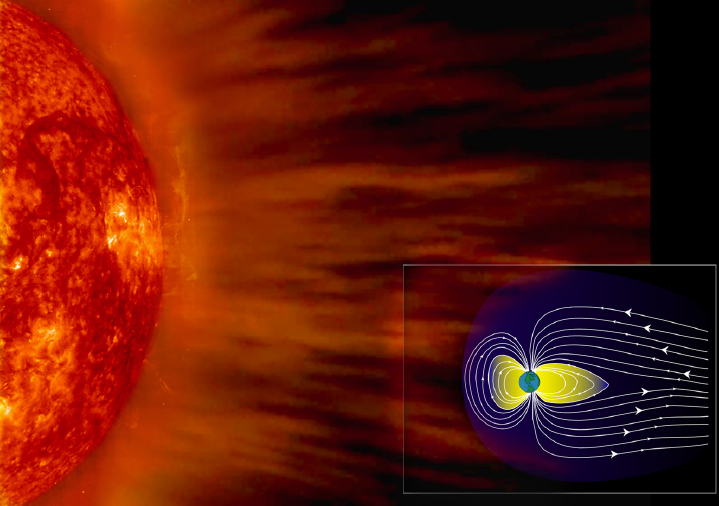
The outer corona is heated up to such high energies that it eventually expands away from the Sun as a stream of electrons, protons and other atomic particles. The stream travels away from the Sun at speeds of around 200-400 km/s but can reach speeds of 900 km/s. The solar wind fills the entire solar system so all the planets sit inside the outer solar atmosphere. We live inside the atmosphere of a star. Sometimes concentrated high-speed solar wind streams come from the Sun and impacts the Earth. These can produce magnetic disturbances in the Earths upper atmosphere called a geomagnetic storm and produce the Southern and Northern Lights (The Aurora).
Solar Flares
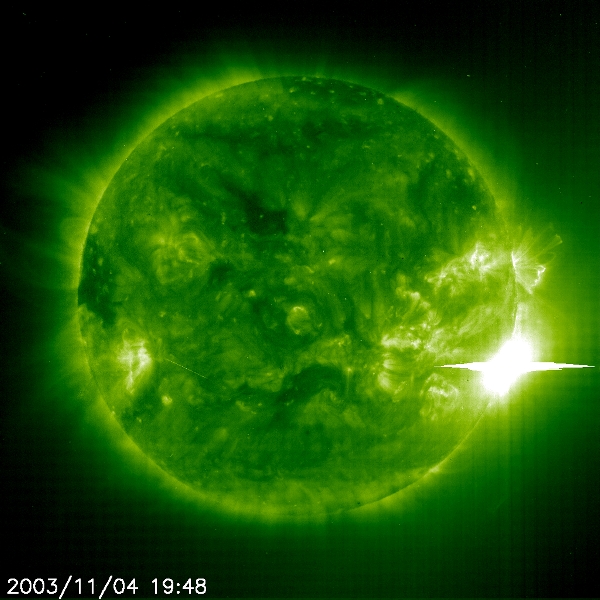
Solar flares are a sudden, explosive release of magnetic energy in the form of electromagnetic radiation (most of the light spectrum, from radio waves to gamma-rays) and very fast atomic particles. Solar flares occur in regions of concentrated magnetic field such as sunspots.
Flares happen when the powerful magnetic fields in and around the sun reconnect. They’re usually associated with active regions, often seen as sun spots, where the magnetic fields are strongest.
Flares are classified according to their strength. The smallest ones are B-class, followed by C, M and X, the largest. Similar to the Richter scale for earthquakes, each letter represents a ten-fold increase in energy output. So an X is 10 times an M and 100 times a C. Within each letter class, there is a finer scale from 1 to 9. C-class flares are too weak to noticeably affect Earth. M-class flares can cause brief radio blackouts at the poles and minor radiation storms that might endanger astronauts.
Although X is the last letter, there are flares more than 10 times the power of an X1, so X-class flares can go higher than 9. The most powerful flare on record was in 2003, during the last solar maximum. It was so powerful that it overloaded the sensors measuring it. They cut-out at X28. A powerful X-class flare like that can create long lasting radiation storms, which can harm satellites and even give airline passengers, flying near the poles, small radiation doses. X flares also have the potential to create global transmission problems and world-wide blackouts.
CREDIT: NASA Goddard Space Flight Center / SDO
Coronal Mass Ejections (CMEs)
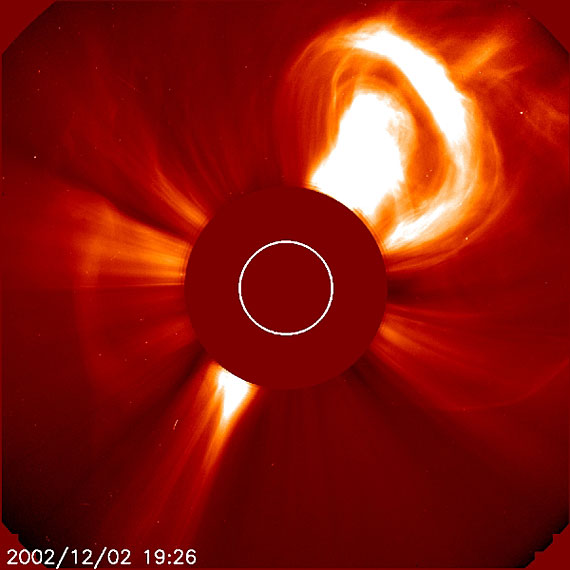
Sometimes when magnetic energy is released the corona becomes so disturbed that large pieces of it are released into space. Billions of tons of solar material and magnetic field are hurled from the Sun into interplanetary space at speeds up to several million mph. As they move away from the Sun they expand becoming as wide across as the distance from the Earth to the Sun. CMEs can occur when filaments/prominences become unstable and fly away from the Sun. We call this a filament/prominence eruption.
On July 23, 2012, a massive cloud of solar material erupted off the sun’s right side, zooming out into space. It soon passed one of NASA’s Solar Terrestrial Relations Observatory, or STEREO, spacecraft, which clocked the CME as traveling between 1,800 and 2,200 miles per second as it left the sun. This was the fastest CME ever observed by STEREO.
Two other observatories – NASA’s Solar Dynamics Observatory and the joint European Space Agency/NASA Solar and Heliospheric Observatory — witnessed the eruption as well. The July 2012 CME didn’t move toward Earth, but watching an unusually strong CME like this gives scientists an opportunity to observe how these events originate and travel through space.
STEREO’s unique viewpoint from the sides of the sun combined with the other two observatories watching from closer to Earth helped scientists create models of the entire July 2012 event. They learned that an earlier, smaller CME helped clear the path for the larger event, thus contributing to its unusual speed.
Such data helps advance our understanding of what causes CMEs and improves modeling of similar CMEs that could be Earth-directed.
CREDIT: NASA Goddard Space Flight Center / SDO
This video features two model runs. One looks at a moderate coronal mass ejection (CME) from 2006. The second run examines the consequences of a large coronal mass ejection, such as The Carrington-Class CME of 1859. These model runs allow us to estimate consequences of a large event hitting Earth, so we can better protect power grids and satellites.
In an effort to understand and predict the impact of space weather events on Earth, the Community-Coordinated Modeling Center (CCMC) at NASA Goddard Space Flight Center, routinely runs computer models of the many historical events. These model runs are then compared to actual data to determine ways to improve the model, and therefore forecasts of future space weather events.
Sometimes we need an actual event to have data for comparison. Extreme space weather events are one example where researchers must test models with a rather limited set of data.
The vertical lines on the left represent magnetic field lines from the sun.
CREDIT: NASA Goddard Space Flight Center / SDO
The Difference Between a CME & a Solar Fare
Coronal mass ejections (CMEs) and flares are both solar events, but they are not the same. This video shows the differences between the two by highlighting specific features of each.
CREDIT: NASA Goddard Space Flight Center
Solar Energetic Particles (SEPs)
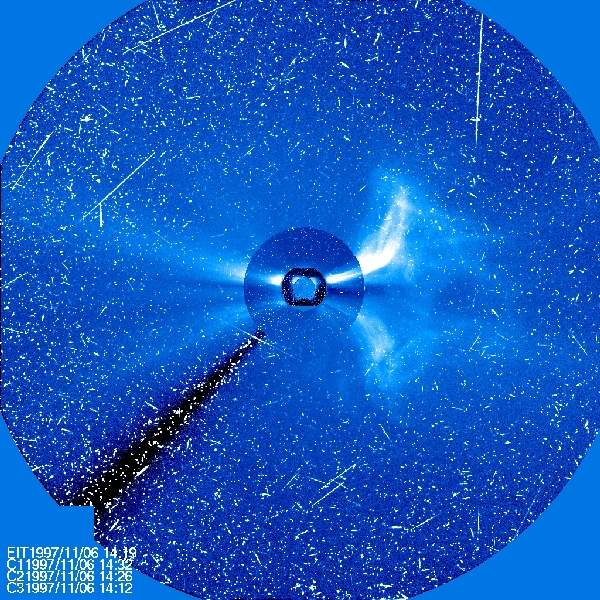
When a large solar flare or CME occurs they can accelerate a large number of atomic particles, electrons, protons and various elements to very high energies. When SEPs impact the cameras on a spacecraft the recorded images look like a television screen with a lot of static or snow.

